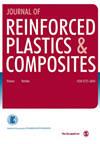Study on the influence of sandwich glass structure on its impact resistance
IF 2.2
3区 材料科学
Q3 MATERIALS SCIENCE, COMPOSITES
引用次数: 0
Abstract
In view of the impact resistance of PVB laminated glass, PVB laminated glass of 0.76 mm and 1.52 mm thickness was selected in this paper to form five different types of “2 + 1” and “3 + 2” sandwich glass, and hydrogen gun flying plate variable speed impact combined with CT scanning and three-dimensional reconstruction technology was adopted. The failure mode and crack expansion of glass specimens after impact are studied. The influence of different factors (sandwich thickness, sandwich number, and sandwich position) on the impact resistance of explosion-proof glass is analyzed comprehensively. The results show that increasing the number and thickness of sandwiches can reduce the widening and expansion of microcracks, decrease crack connectivity, and effectively resist plastic damage to glass specimens. The appropriate position of the sandwich helps to improve the load-bearing capacity of the glass specimens. Therefore, the thickness of the sandwich, the number of sandwiches, and the position of the sandwich all have an impact on the impact load capacity and crack development of laminated glass. In addition, the impact resistance of laminated glass is positively correlated with the thickness of the PVB sandwich but shows different damage sensitivity to different impact velocities, with the best impact resistance under its medium velocity condition. This paper provides a significant theoretical foundation for establishing selection criteria for explosion-proof glass by examining the factors that influence its impact resistance, thereby enhancing its safety performance.夹层玻璃结构对其抗冲击性能影响的研究
针对 PVB 夹层玻璃的抗冲击性能,本文选取了厚度分别为 0.76 mm 和 1.52 mm 的 PVB 夹层玻璃,形成五种不同类型的 "2+1 "和 "3+2 "夹层玻璃,并采用氢枪飞板变速冲击结合 CT 扫描和三维重建技术。研究了冲击后玻璃试样的破坏模式和裂纹扩展情况。综合分析了不同因素(夹层厚度、夹层数量、夹层位置)对防爆玻璃抗冲击性能的影响。结果表明,增加夹层的数量和厚度可以减少微裂纹的扩大和扩展,降低裂纹的连通性,有效抵抗玻璃试样的塑性损伤。夹层的适当位置有助于提高玻璃试样的承载能力。因此,夹层厚度、夹层数量和夹层位置都会对夹层玻璃的冲击承载能力和裂纹发展产生影响。此外,夹层玻璃的抗冲击能力与 PVB 夹层的厚度呈正相关,但对不同冲击速度的破坏敏感性不同,其中中速条件下的抗冲击能力最好。本文通过研究影响防爆玻璃抗冲击性能的因素,为建立防爆玻璃的选择标准提供了重要的理论基础,从而提高了防爆玻璃的安全性能。
本文章由计算机程序翻译,如有差异,请以英文原文为准。
求助全文
约1分钟内获得全文
求助全文
来源期刊

Journal of Reinforced Plastics and Composites
工程技术-材料科学:复合
CiteScore
5.40
自引率
6.50%
发文量
82
审稿时长
1.3 months
期刊介绍:
The Journal of Reinforced Plastics and Composites is a fully peer-reviewed international journal that publishes original research and review articles on a broad range of today''s reinforced plastics and composites including areas in:
Constituent materials: matrix materials, reinforcements and coatings.
Properties and performance: The results of testing, predictive models, and in-service evaluation of a wide range of materials are published, providing the reader with extensive properties data for reference.
Analysis and design: Frequency reports on these subjects inform the reader of analytical techniques, design processes and the many design options available in materials composition.
Processing and fabrication: There is increased interest among materials engineers in cost-effective processing.
Applications: Reports on new materials R&D are often related to the service requirements of specific application areas, such as automotive, marine, construction and aviation.
Reports on special topics are regularly included such as recycling, environmental effects, novel materials, computer-aided design, predictive modelling, and "smart" composite materials.
"The articles in the Journal of Reinforced Plastics and Products are must reading for engineers in industry and for researchers working on leading edge problems" Professor Emeritus Stephen W Tsai National Sun Yat-sen University, Taiwan
This journal is a member of the Committee on Publication Ethics (COPE).
 求助内容:
求助内容: 应助结果提醒方式:
应助结果提醒方式:


